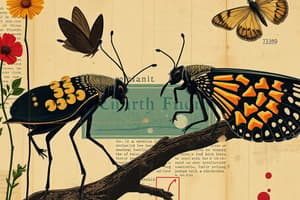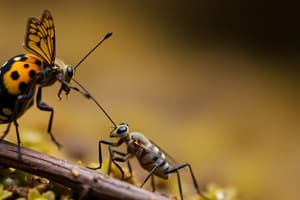Podcast
Questions and Answers
What is the primary reason why plants with bigger seeds may find themselves without dispersers?
What is the primary reason why plants with bigger seeds may find themselves without dispersers?
- Because of the loss of mutualistic relationships
- Because larger animals are often more vulnerable (correct)
- Because smaller animals cannot disperse large seeds
- Because of human-driven defaunation
What is the impact on damselfish when cleaner fish consume more mucus and scales?
What is the impact on damselfish when cleaner fish consume more mucus and scales?
- Their scales become thicker
- Their immune system becomes stronger
- Their infection resistance decreases (correct)
- Their reproductive rate increases
What is the result of the loss of large seed dispersers on local plant neighbourhoods?
What is the result of the loss of large seed dispersers on local plant neighbourhoods?
- Increased seed dispersal distances
- Higher genetic diversity
- Reduced plant growth
- Smaller effective population sizes (correct)
What is the average change in flowering times over the past 3 decades?
What is the average change in flowering times over the past 3 decades?
What is the primary reason for the reduction of seed dispersal distances?
What is the primary reason for the reduction of seed dispersal distances?
What is the role of Gallotia lizards in the ecosystem?
What is the role of Gallotia lizards in the ecosystem?
What is the relationship between the size of seeds and the size of animals that disperse them?
What is the relationship between the size of seeds and the size of animals that disperse them?
What is the outcome when one organism stops providing benefits in a mutualistic relationship?
What is the outcome when one organism stops providing benefits in a mutualistic relationship?
What do mucus and scales provide to damselfish?
What do mucus and scales provide to damselfish?
What did the study on wild onion plants reveal about their relationship with fungi?
What did the study on wild onion plants reveal about their relationship with fungi?
What is the primary benefit that ants receive from aphids in their mutualistic relationship?
What is the primary benefit that ants receive from aphids in their mutualistic relationship?
What is the characteristic of endomycorrhizal fungi that allows them to form a mutualistic relationship with plants?
What is the characteristic of endomycorrhizal fungi that allows them to form a mutualistic relationship with plants?
What is the estimated time period during which the mutualism between plants and mycorrhizal fungi first evolved?
What is the estimated time period during which the mutualism between plants and mycorrhizal fungi first evolved?
What is the primary benefit that plants receive from mycorrhizal fungi in their mutualistic relationship?
What is the primary benefit that plants receive from mycorrhizal fungi in their mutualistic relationship?
What type of mutualist is an aphid that interacts with a single species of ant?
What type of mutualist is an aphid that interacts with a single species of ant?
What is the term for a mutualistic relationship in which two species provide fitness benefits to each other but the interaction is not critical to the persistence of either species?
What is the term for a mutualistic relationship in which two species provide fitness benefits to each other but the interaction is not critical to the persistence of either species?
What is the estimated number of species of mycorrhizae involved in mutualistic relationships with plants?
What is the estimated number of species of mycorrhizae involved in mutualistic relationships with plants?
What is the primary benefit that plants provide to mycorrhizal fungi in their mutualistic relationship?
What is the primary benefit that plants provide to mycorrhizal fungi in their mutualistic relationship?
Why was the mutualism between plants and mycorrhizal fungi likely necessary for plants to adapt to land?
Why was the mutualism between plants and mycorrhizal fungi likely necessary for plants to adapt to land?
What is the term for a mutualistic relationship in which two species provide fitness benefits to each other and require each other to persist?
What is the term for a mutualistic relationship in which two species provide fitness benefits to each other and require each other to persist?
What is the primary function of Rhizobium bacteria in mutualistic relationships with legumes?
What is the primary function of Rhizobium bacteria in mutualistic relationships with legumes?
What is the benefit of the relationship between the Yao hunters and the greater honeyguide birds?
What is the benefit of the relationship between the Yao hunters and the greater honeyguide birds?
What is the result of removing ants from the whistling thorn acacia trees?
What is the result of removing ants from the whistling thorn acacia trees?
What is the term used to describe the study of the network of interactions between species in pollination?
What is the term used to describe the study of the network of interactions between species in pollination?
What is the function of the antibacterial compounds produced by ants in the whistling thorn acacia trees?
What is the function of the antibacterial compounds produced by ants in the whistling thorn acacia trees?
What is the role of the blue-tailed day-gecko in the ecosystem of Mauritius?
What is the role of the blue-tailed day-gecko in the ecosystem of Mauritius?
What is the characteristic of ectomycorrhizal fungi that distinguishes them from other fungi?
What is the characteristic of ectomycorrhizal fungi that distinguishes them from other fungi?
What is the benefit of the relationship between the whistling thorn acacia and the ants?
What is the benefit of the relationship between the whistling thorn acacia and the ants?
What is the term used to describe the nodes in a pollination network?
What is the term used to describe the nodes in a pollination network?
What is the significance of studying pollination networks?
What is the significance of studying pollination networks?
Flashcards are hidden until you start studying
Study Notes
Mutualism
- A mutualism is a positive interaction between two species where both receive benefits.
- Mutualists can be generalists (interacting with many species) or specialists (interacting with one or a few species).
Types of Mutualists
- Obligate mutualists: two species that provide fitness benefits to each other and require each other to persist.
- Facultative mutualists: two species that provide fitness benefits to each other, but the interaction is not critical to the persistence of either species.
Examples of Mutualisms
- Aphids and ants: aphids produce a carbohydrate-rich droplet consumed by ants, and ants protect aphids from predators.
- Mycorrhizal fungi and plants: fungi provide plants with soil minerals and water, and plants provide fungi with sugars from photosynthesis.
- Legumes and Rhizobium bacteria: legumes provide bacteria with photosynthesis products, and bacteria convert atmospheric nitrogen into ammonia usable by plants.
- Humans and greater honeyguide birds: humans follow honeyguides to locate beehives, and honeyguides consume bee larvae and wax.
Mycorrhizal Fungi
- Endomycorrhizal fungi: surround plant roots, extend far into soil, and penetrate root cells, providing essential nutrients to plants.
- Ectomycorrhizal fungi: surround plant roots, enter between root cells, and provide nutrients to plants, often found in relationships with trees and shrubs.
Mutualisms in Ecosystems
- Mutualistic interactions between plants and bacteria convert unusable minerals into forms usable by plants.
- Whistling thorn acacia and ants: ants occupy acacia's hollow spine base, providing protection against herbivores and spreading antibacterial compounds.
Pollination
- Many plants rely on animals for pollination, including insects, mammals, and birds.
- The blue-tailed day-gecko is the sole pollinator and seed disperser of the endangered Rousseau simplex plant.
Networks of Interactions
- Networks can describe which species interact with which, with nodes representing species and links representing interactions.
- Networks can reveal redundancy and complementarity of interactions in ecosystems and can be used to study changes to communities if one species is lost.
Seed Dispersal
- Many species disperse seeds of many plants, with a size relationship between animal and seed size.
- Losing animals, especially larger ones, can lead to the extinction of plants that depend on them for dispersal.
Importance of Mutualisms
- Mutualisms can be crucial for the survival of species, especially in certain environments.
- The loss of mutualisms can have cascading effects on ecosystems.
Studying That Suits You
Use AI to generate personalized quizzes and flashcards to suit your learning preferences.




